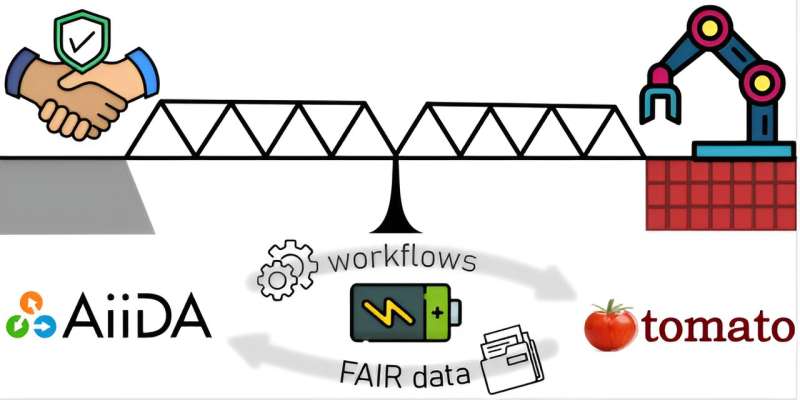This article has been reviewed according to Science X's editorial process and policies. Editors have highlighted the following attributes while ensuring the content's credibility:
fact-checked
peer-reviewed publication
proofread
Computational workflow engine, matched with robotic platform, used to drive experiments for the first time

Computational and experimental methods in materials science are often described as entirely separate affairs. On one side, computer simulations are used to explain and predict the properties of materials, including novel ones that were not yet synthesized. On the other, experiments test the actual behavior of materials in controlled situations and serve to confirm and validate computational predictions.
But the way forward for materials science is really to have the two methods go hand in hand, as it happened in a new publication in Journal of Materials Chemistry A, co-led by NCCR MARVEL's members Giovanni Pizzi and Nicola Marzari with Empa's Corsin Battaglia, and involving researchers from the Paul Scherrer Institute (PSI), Empa, EPFL, ETH Zurich, and Technische Universität Berlin.
The researchers demonstrated how the computational workflow engine AiiDA, developed within NCCR MARVEL, can be used not only to run simulations, but to run actual experiments, in this case on batteries, from controlling the experimental devices, to archiving and analyzing the resulting data.
"There were several components involved in the setup," explains Edan Bainglass, a scientist in Giovanni Pizzi's group at PSI.
"To begin with, there is a robot, Aurora, that can assemble up to 36 coin cell batteries with different battery components at the time." Once the batteries are ready to go, they are placed into racks of battery cyclers that repeatedly charge and discharge the batteries under different conditions.
Next, tomato, an open-source software tool developed at Empa, the Swiss Federal Laboratories for Materials Science and Technology, is used to control the operation of cyclers, setting parameters such as voltage and current and putting the batteries through the desired cycles of charge and discharge.
"The software takes care of communicating with the cyclers, collecting the data, and parsing the results directly into files that can be further processed," explains Peter Kraus, main developer of tomato, formerly in Empa and now in Technische Universität Berlin.
The core of the new study is exactly the integration of AiiDA with tomato, in such a way that one can write AiiDA workflows and use AiiDA to control the cycling of batteries. The advantage is that now a set of cycling protocols can be assigned per sample in a cycling workflow, and multiple samples may be submitted at a time, limited only by the number of available cyclers.
"Otherwise, for every experiment and every protocol that you would want to run with tomato, you'd have to do it one by one," says Bainglass.
Let's say, for example, that an experiment implies first putting a battery through a formation cycle, to create the passivating electrode/electrolyte interface, and then later applying long-term cycling. Instead of setting up each of these protocols manually per sample, AiiDA allows researchers to prepare an experiment through a graphical interface by packing together several protocols and submitting them as a batch on as many samples as you can handle, with various checks along the way.
"Plus, you have the usual benefits of AiiDA when it comes to collecting and analyzing the data, including full provenance tracking of the data. Furthermore, thanks to tailored web interfaces (apps) that we developed in AiiDAlab, our overall platform becomes a one-stop shop for batch submission, data collection, provenance tracking, and analysis," says Bainglass.
"This is the first time that AiiDA is used to drive automated experiments rather than simulations, using the same underlying philosophy, data structure and workflow engine," notes Giovanni Pizzi.
"Our tight integration of automated simulations and experiments is the first crucial step toward a fully integrated platform enabling in the future fully autonomous self-driving labs."
More information: Peter Kraus et al, A bridge between trust and control: computational workflows meet automated battery cycling, Journal of Materials Chemistry A (2024). DOI: 10.1039/D3TA06889G


















